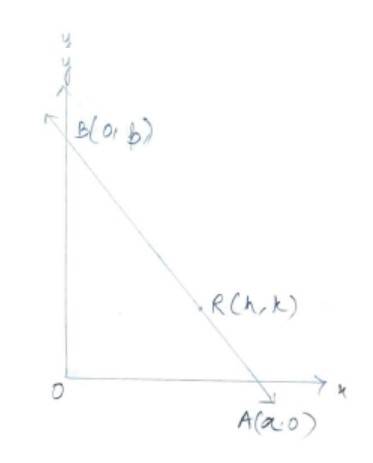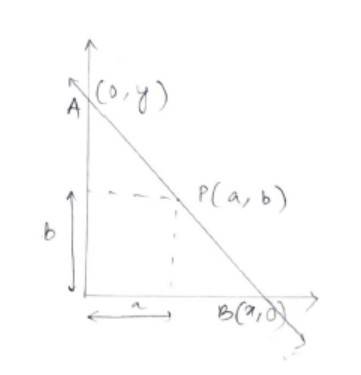Ncert Solutions Maths class 11th
Get insights from 1.6k questions on Ncert Solutions Maths class 11th, answered by students, alumni, and experts. You may also ask and answer any question you like about Ncert Solutions Maths class 11th
Follow Ask QuestionQuestions
Discussions
Active Users
Followers
New answer posted
4 months agoContributor-Level 10
10. Given, n (A * A)=9
n (A) *n (A) = 9.
n (A)2 = 32.
n (A) = 3 .
And (–1,0), (0,1) A * A i.e., A * A = { (x, y), x A, y B}
? A= {–1,0,1}
And A * A= {–1,0,1} * {–1,0,1}
= { (–1, –1), ( –1,0), ( –1,1), (0, –1), (0,0), (0,1), (1, –1), (1,0), (1,1)}
New answer posted
4 months agoContributor-Level 10
9. Given, n (A)=3
n (B)= 2
So, n (Ax B)=n (A).n (B)=3x 2=6
as (x, 1), (y, 2), (z, 1) ∈Ax B= { (x, y), x∈Aand y∈B}.
A= {x, y, z} and B= {1,2}
As n (A) = 3as n (B) = 2
New answer posted
4 months agoContributor-Level 10
36.
Let the given points be A (3, 0), B (–2, –2) and C (8, 2). Then by two point form we can write equation of line passing point A (3, 0) and B (–2, –2) as
If the three points A, B and C are co-linear, C will also lieonm the line formed by AB or satisfies equation (1).
Hence, putting x = 8 and y = 2 we have
L.H.S. = 2 * 8 – 5 * 2 – 6
= 16 – 10 – 6
= 0 = R.H.S.
The given three points are collinear.
New answer posted
4 months agoContributor-Level 10
8. A Given, A= {1,2}
B= {3,4}
So, A* B= { (1,3), (1,4), (2,3), (2, 4)}
i.e., n (A *B)=4
A *B will have subset =24=16.They are,
Φ, { (1,3)}, { (1,4)}, { (2, 3)}, { (2,4)}, { (1,3), (1,4)}, { (1,3), (2,3)},
{ (1,3), (2, 4)}, { (1,4), (2, 3)}, { (1,4), (2, 4)}, { (2,3), (2, 4)},
{ (1,3), (1,4), (2, 3)}, { (1,3), (1,4), (2,4)}, { (1,3), (2,3), (2, 4)}, { (1,4), (2,3), (2,4)},
and { (1,3), (1,4), (2,3), (2,4)}
New answer posted
4 months agoContributor-Level 10
7. Given,
A= {1, 2}, B = {1,2,3,4}, C= {5,6} and D= {5,6,7,8}
(i) L.H. S = A * (B∩ C) = {1,2} [ {1,2,3,4} ∩ {5,6}]
= {1,2}*
= .
R.H.S = (A* B)∩ (A *C)= [ {1,2}* {1,2,3,4}]∩ [ {1,2} {5,6}]
= [ { (1, 1), (1, 2), (1, 3), (1, 4), (2, 1), (2, 2), (2, 3), (2, 4)]∩ [ {1,5), (1,6), (2,5), (2,6)}]
= .
Hence, L.H.S= R.H.S.
(ii) A* C = {1, 2}* {5,6}
= { (1,5), (1,6), (2,5), (2,6)}
B* D = {1,2,3,4} * {5,6,7,8}
= { (1,5), (1,6), (1,7), (1,8), (2,5), (2,6), (2,7), (2,8), (3,5), (3,6), (3,7), (3,8), (4,5), (4,6), (4,7), (4,8)}
As every element of A C is also an element of B* D.
A *C B *D
New answer posted
4 months agoContributor-Level 10
35. Equation of line with intercept form is
As R (h, x) divides line segment joining point A (a, 0) and B (0, b) in the ratio 1 : 2 we can write,
So,
Hence, putting value of a and b in equation (1) we get,
New answer posted
4 months agoContributor-Level 10
6. Given,
A *B = { (a, x), (a, y), (b, x), (b, y)}
We know that,
A *B = { (p, q); p ∈ A and q ∈ B}
So, A = {a, b} and B = {x, y}.
New answer posted
4 months agoContributor-Level 10
34.
Since P (a, b) is the mid-point of the line segment say AB with points A (0, y) and B (x, 0) we can write,
So, the equation of line with x and y intercept 2a and 2b using intercept form is
Hence, proved
New answer posted
4 months agoContributor-Level 10
5. Given, A = {1,1}
So, A* A = { (1,1), (1,1), (1,1), (1,1)}
A *A *A = { (1,1), (1,1), (1,1), (1,1)} * {1,1}
= { (1,1.1), (1, 1), (1, ), (1,1,1), (1,1,1), (1,1), (1,1), (1,1,1)}
New answer posted
4 months agoContributor-Level 10
4. (i) False. Here P = {m, n}, n (p)=2
Q = {n, m}, n (Q)=2
n (P* Q) = n (P)* n (Q) = 2* 2 = 4.
So, P *Q = { (m, n), (m, m), (n, n), (n, m)}
(ii) True.
(iii) True. { A * (B ∩ ?) = A* ? . {∴ B ∩ ? = ? }
= n (A) *0 {? is empty set}
= ?
Taking an Exam? Selecting a College?
Get authentic answers from experts, students and alumni that you won't find anywhere else
Sign Up on ShikshaOn Shiksha, get access to
- 65k Colleges
- 1.2k Exams
- 687k Reviews
- 1800k Answers


